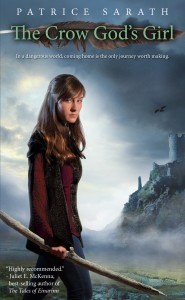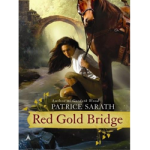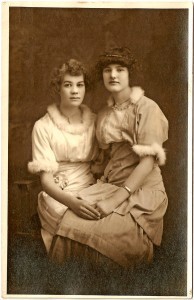Patrice Sarath's Blog, page 23
July 18, 2013
What readers want

A book is like a faerie door — enter at your own peril.
Announcing a new blog series, and I’m looking for your input. What Readers Want asks readers of all genres what they are looking for in a good book (or not so good book, we don’t judge). This isn’t market research per se; no one is going to run out and write a book based on elements people post here. But it’s a fair way to get at the mystery of what makes a good book.
So readers: Are there things you miss in books? Things you love? Things you are so over, you wish the genre would move on already?
Tell us all about the characters, plots, and settings that make your heart sing or the opposite — the ones that disappointed. I want to hear from you!
What Readers Want:
What do you like in a good book?
What ruins a book for you?
I want a protagonist who…
I want an antagonist who…
I long for settings and plot that…
I like series that…
I will read anything that has…
Answer in the comments or ping me with an e-mail on the contact form.
The post What readers want appeared first on Author Patrice Sarath.
July 14, 2013
The Crow God’s Girl for 99 cents!
 We’re halfway through the summer and you need something NEW to read for the beach/plane/road trip whatever.
We’re halfway through the summer and you need something NEW to read for the beach/plane/road trip whatever.
The Crow God’s Girl is only 99 cents on Smashwords. Select any file format, download your copy, and start reading. I promise it will be a cool interlude in a hot summer.
Use COUPON CODE: LU89S
Here’s an excerpt to whet your appetite:
“Young fosterling,” the woman said. “Is this yours?”
She let a pair of panties dangle from a long finger. Even if they hadn’t been a tiny bikini cut of red gingham with a dainty rose bow on the front that she had bought with her own money and then hidden from her mother, Kate would have known they were hers. No one had underwear here. Her face flamed.
“Why do you have my underwear?”
“I found them in the young master’s chambers.”
Kate knew she went from red-faced to white in one second. No way. No. Way. She had never been in Colar’s room. Ever. So who was planting her underwear in her fiance’s bedroom? She didn’t try to protest. Samar watched her narrowly, her gray, lined face impassive.
“I can’t believe that.” Kate’s voice went flat.
One gray eyebrow arched delicately, and Samar tossed her the little scrap. “You best keep better track of your things,” she said, and turned and left her.
Kate crushed the panty in her fist. She had to wash it when she first arrived in Terrick; she remembered washing it. It was her only pair. And then, she was given clothes to wear, including the strange pair of bloomers. And she must have forgotten the panties. At least, she thought, it hadn’t been the bra. That she was able to wash and dry overnight before the fire, and since she couldn’t quite manage the stays that she was given along with the bloomers, she stuck with the bra. So she had lost track of the panties and someone had taken them and planted them in Colar’s bedroom.
With an eye on the door, she hastily stuck the panties under the lumpy mattress, pulling the ticking back into place.
So who had it in for her? she thought, as she left the room and closed the door behind her, with a backward, considering, glance.
The better question might be, who didn’t?
The post The Crow God’s Girl for 99 cents! appeared first on Author Patrice Sarath.
July 12, 2013
Writing lessons — a writer’s toolbox
Note: This is a post in an occasional series of reprints. Not necessarily my greatest hits, these posts are just some of my most useful commentary that may have gotten buried in the mists of time. This post first appeared in April, 2009.
If you’ve been listening to NPR today you know that The Elements of Style is 50 years old. This is the book commonly referred to as Strunk & White after its authors, William Strunk and E.B. White (Stuart Little, The Trumpet of the Swan, Charlotte’s Web).
Writers don’t need much — but a case can be made that this book is essential for any writer’s toolbox. I think they’ve tarted it up in recent years, but early editions were all of about 80 pages, and that’s the edition I suggest you find at your local used bookstore.
S&W is famous for its simple rules. “Omit needless words” is one of the most famous of its admonishments. You’d be surprised at how that works for writers. Try it on your next edit.
The book covers punctuation, usage (or grammar), style, and commonly misused words. It’s essential. Often aspiring writers neglect to pay attention to language and grammar, but you will find that professional authors rarely put a foot wrong. It’s not that the pros are naturally gifted with an understanding of the written word, although we tend to have a leg up — it does come easily to us. But it is essential to be familiar with and competent in the use of grammar and style in order to make the next step from aspiring to pro.
In addition to Strunk & White and a dictionary, look into a book on writing. Stephen King’s On Writing is a good source of inspiration, understanding, and solid rules for writers. The autobiographical details are fascinating too.
Ann Lamott’s Bird By Bird was my go-to book on writing. I wrote my first selling story after reading her book (The Warlord and the Princess, on this site). But choosing a book on writing is a pretty personal decision. You may find that Steering the Craft by Ursula Le Guin is more to your taste; plus, she has the home-court advantage, as it were, since she is one of us. Writing Down the Bones by Natalie Goldberg is an oldie but goodie. It didn’t work for me but I know people who swear by it.
One more thing — I mentioned a dictionary but not a thesaurus. People get sniffy about thesauruses, saying that they encourage irresponsible word choice. Why use an exotic alternative when a good basic word will do just as well? However, when used sparingly, a thesaurus can be an asset. Just don’t go overboard, because I will have to rescind my permission.
Finally, I will leave you with the words of Mark Twain, because really, what more do you need: “The difference between the right word and the almost-right word is the difference between the lightning and the lightning-bug.”
The post Writing lessons — a writer’s toolbox appeared first on Author Patrice Sarath.
July 7, 2013
Lessons from the Writers League — Part III
Why go to a writers’ conference?
The Writers’ League of Texas annual conference was an eye-opening experience. I learned so much and got so much out of it, it re-energized my writing (and my blogging, as you can see). I can’t recommend the experience enough. Here are some reasons for going to a general writers’ conference.
Get out of your comfort zone.
Maybe you’ve been used to going to genre conventions. You think a writers conference may be too big, or you feel like you won’t have anything in common with other attendees, since they may write in other genres (or, in the case of romance and SF authors, possibly hold your genre in contempt). Go, I say! It’s a shared journey. You’ll find kindred spirits. And you might even find a kindred spirit who’s writing memoir and you’re writing military SF — and she’s served in the military and would be happy to critique your WiP to get the particular details right about military life.
Leading to:
Networking.
I’m an introvert. Oh, I talk a good game, but there’s a reason I’m a writer. Conversation with strangers is scary. By taking a deep breath and chatting up strangers, asking about their stories, I can broaden my network of fellow writers, perhaps even enlisting new critique partners.
An entire conference dedicated to craft, publishing information, marketing, and more.
So you go to genre conventions, and you attend all the publishing track panels you can. That’s still just one track. A general writers’ conference is an embarrassment of riches. There’s so much to learn, you can’t go to it all. That’s when you and your new buddy, the one you met at the breakfast welcome luncheon, divvy up the panels and compare notes later. It’s just more bang for your buck. Are they more expensive than a con? Yes, and they are worth every penny.
And finally:
Professionalism.
Right now the science fiction convention scene is wracked by scandal. The revelations of sexual harrassment by pros and big-name fans has given the con circuit a black eye. Well deserved, I might add. Of the two general writers’ conferences I’ve been to this year, there hasn’t even been a whiff of scandal. here was never any sense that the attendees and pros — the agents and editors who were invited as panelists — were anything but professional and hard-working, approachable (but please, no pitching scripts in the restrooms!), and nice.
What have been your experiences at writers’ conventions?
Go to Part I and Part II for more Lessons from the Writers’ League.
The post Lessons from the Writers League — Part III appeared first on Author Patrice Sarath.
July 2, 2013
YA vs NA
What’s the difference between YA and NA (New Adult)?
Depends on who you talk to. For some agents and editors, NA specifically means sexytimes, and NA is therefore shelved with women’s fiction. For other agents and editors, NA may have adult themes and older protagonists, but it doesn’t have to have adult sexual content.
With so many adult readers reading YA, it was inevitable that novels aimed at the 18-25 year old bracket would make it onto the shelves. I myself believe that it directly comes out of the fanfic and slash fandom communities. I think NA can be a fantastic addition to books for adult readers. Some YA is middle grade and younger, and while it’s great stuff, it doesn’t have the sophistication (perhaps) that can be enjoyed by older readers. Also, many 16 year olds may not want to be seen reading stuff for younger kids.
 But does that mean that YA for older (say 16-18 year olds) is going to give way? Will there be a market for books for older teens that explores adult themes but doesn’t necessarily include adult content? Are we narrowbanding the genre and constricting it so much that we lose some of the upper-age group for this genre?
But does that mean that YA for older (say 16-18 year olds) is going to give way? Will there be a market for books for older teens that explores adult themes but doesn’t necessarily include adult content? Are we narrowbanding the genre and constricting it so much that we lose some of the upper-age group for this genre?
In my own books, the Gordath Wood series, they are definitely not YA, though the character of Kate Mossland is just barely 16 in the first book, and is only 17 by the third — and by then she has not only grown up, she has changed the very course of the history of her adopted country, and is embarking on a relationship with an older man. Although there is frank talk of sexuality, especially birth control, there is very little sexual content.
What do you think of the new NA genre?
The post YA vs NA appeared first on Author Patrice Sarath.
June 30, 2013
Lessons from the Writers’ League — Part II
Last week’s Writers’ League of Texas Agents and Editors Conference was an eye opener for me. I mostly attend science fiction conferences, and they perform a quite different function from a general writers conference. Cons are for fans and authors to meet and mingle, share their love for the genre, and meet on the same level. Writers conferences are learning experiences, and you don’t have to be a newbie to get plenty out of them.
I blogged last week about what you do have control over in this crazy business, based on author and editor Chuck Sambuchino’s excellent keynote address. You can read that post here.
I also had the good fortune to go to agent Sarah Davies’ (Greenhouse Literary) panel on writing thrillers, whether for YA or for adults.
How to Write a Thriller
You need:
A sympathetic character
A hook
A fast-paced, high-stakes plot
No pantsing! Plot out everything in advance and work backward from the ending
Puzzles, red herrings, and setbacks
A strong sense of place
Emotional heft
An instigating event that happens before page 25
Cliffhanger chapter endings
Easy, right? Well, not really (but we knew that). As Davies said, thrillers need a character who readers can love (she says her husband has a bit of a man crush on Jack Reacher), but who is also flawed. Perfection is boring; we are drawn to characters whose lives are messy, and whose messes get them into trouble. Hence the plot, since plot is driven by character.
Give the hero a past and it impacts the present, especially with a shocker out of the past. Davies also quoted Stephen King: “I create sympathy for my characters and then turn the monsters loose.”
All novels have an aspect of the thriller in them. We readers are drawn to finding out what happens next, and even so-called “literary” novels are constructed to keep us turning the pages. (I think the days of the abstruse literary novel are over, but I could be wrong about that). Thrillers meet our need for knowing the end of the story, and there’s nothing cheap or easy about that.
The post Lessons from the Writers’ League — Part II appeared first on Author Patrice Sarath.
June 26, 2013
iPad setup for writers
 If you are looking for a good iPad setup for writers, here’s my new traveling system. It was so easy to bring this on vacation, especially since you don’t have to put your iPad in a separate bin when going through security or turn it on, or anything. Just leave it in your carry on. I never thought I would be able type on something this small, but the keyboard is surprisingly comfortable.
If you are looking for a good iPad setup for writers, here’s my new traveling system. It was so easy to bring this on vacation, especially since you don’t have to put your iPad in a separate bin when going through security or turn it on, or anything. Just leave it in your carry on. I never thought I would be able type on something this small, but the keyboard is surprisingly comfortable.
The only caveat is that the keyboard and iPad use Bluetooth to talk, and boy does that go through the battery charge like nobody’s business. I settled in to wait for my flight with a couple of books I had uploaded via my Kindle app the night before, and much to my surprise the iPad was dead because I left the Bluetooth connection on. Live and learn. And it’s not so bad to make an emergency dash to the airport bookstore. (I picked up Tina Fey’s Bossypants, for the record.)
Setup:
iPad
Apple wireless keyboard
Word Touch Document Writer (very usable; you can transfer documents to and from Dropbox. It only supports .docx and html formats, though, no rtf or other formats, but even I could resave from .rtf to .doc.
It won’t replace my laptop, which pretty much just lives in my office now as a de facto desktop now, but I feel comfortable using the iPad for traveling and coffee shop or library writing.
The post iPad setup for writers appeared first on Author Patrice Sarath.
June 23, 2013
Lessons from the Writers League — Part I
Lessons from the Writers League of Texas conference.
I spent Saturday at the Writers League of Texas Agents & Editors Conference and came away with a lot of practical advice and information. Everyone was eager, professional, and wonderful to talk to and work with. My panels, on historical fiction and alternative worlds, were well-attended, and panelists and audiences had plenty to share.
Chuck Sambuchino‘s keynote address. Chuck is an editor at Writers Digest and he writes a Guide to Literary Agents blog that is one of the most popular on the Web. As Chuck says, there’s so much the writer can’t control. So what does a writer have control over? (Note: I have made plenty of these mistakes.)
Chuck Sambuchino’s Top Things You Have Control over as a Writer
Always write the best thing you can. Polish, edit, prepare. It’s not someone else’s job to fix your errors.
Investigate all publishing options and research them carefully. This means self-publishing and traditional publishing. Don’t get blindsided. Know what you are getting into.
Create and develop a platform and always be visible in the marketplace.
Keep moving forward. This is the number one thing, according to Chuck. Don’t stop after one rejection or two or multiple. Keep writing the next thing, keep developing the next project, keep going.
Don’t put all your eggs in one basket. Agents always want to know what else you are working on. They don’t want to take on one-book authors.
It’s okay to write for money.
Don’t believe everything you hear.
Don’t give agents a reason to say no. This goes back to writing the best that you can.
Steal from yourself. If you have an old idea, repurpose it for articles, short stories, novels, etc. Maximize the value of what you write.
Success comes from rejection. Keep going forward and find the right publisher.
And the number one secret to writing. Are you ready for this?
Drum roll, please…
Put down the remote control.
The post Lessons from the Writers League — Part I appeared first on Author Patrice Sarath.
June 21, 2013
Writers League of Texas Agents & Editors Conference
I’ve updated my appearances for the next few months. This weekend I’ll be at the Writers League of Texas Agents & Editor Conference on two panels:
Favorite Past Time: Writing Historical Fiction
Panelists: Jacqueline Kelly, John Pipkin, Carol Dawson, Taylor Martindale
Moderator: Patrice Sarath
Saturday, 10:15 – 11 am
Alternate Worlds: Writing Speculative Fiction
Panelists: Mari Mancusi, Patrice Sarath, Brian Yansky
Moderator: Salima Alikhan
Saturday, 3 – 4 pm
The post Writers League of Texas Agents & Editors Conference appeared first on Author Patrice Sarath.
May 19, 2013
Bandit Girls second draft complete
 The second draft of Bandit Girls is now complete. One more pass — or half-pass — should do it before I send it to my beta readers.
The second draft of Bandit Girls is now complete. One more pass — or half-pass — should do it before I send it to my beta readers.
What have you learned, Dorothy?
I learn something with every book I write and this one is no different. In this case, I have a better understanding of what I want each part of the book to do. Every scene has to have multiple purposes; it must advance the plot and our understanding the characters and the world in which they live. While this may appear formulaic, the point is that it’s not about me and what I want; it’s about what will engage the reader and pull them through to the end.
Writing the ending
I’ve often said that I usually know the ending of my books about two-thirds of the way in. In several books I’ve written the ending, and then gone back and written toward it. Bandit Girls was a little different; I didn’t write the ending in advance, but I knew where it had to end up. And lo, although at that point I was writing organically, it all came together with a great satisfying conclusion.
Outlining vs. Pantsing
I am beginning to see the virtues of outlining. I’m not saying that I will do a formal outline for my next book (although I’m leaning that way), but with the minimalist outline that I did for BG, I could see where it kept me going on the right path instead of allowing the story to deviate from where it should go. The proof is in the pudding, or rather the cut file; it’s probably my smallest cut file to date. Note to aspiring writers; save everything you cut from your working draft in a cut file. It’s not a question of if you will need it, but when. A small cut file means that these deviations are fewer, saving time, and making the first draft go more smoothly. As a former died-in-the-wool pantser, that’s the kind of improvement I can get behind.
Does an outline make a work less imaginative? I used to think that, but talking with friends who are staunch outliners, and reading their manuscripts, I have changed my opinion on that. Their work is wonderfully inventive.
Writing The End
The two most important words a novelist — especially an aspiring novelist — can write are: The End. It signals a project completed and a commitment kept. You learn more from completing a novel that doesn’t work very well (note: there are no “bad” novels, just novels that don’t work very well) than from dozens of fabulous novel starts. Remember that, even when the middle-of-the-book-suck has you in its merciless grip.
But when it comes right down to it, The End is just the beginning. It’s the beginning of the editing process, the redrafting, the polishing, and possibly, the publication process. No matter how many novels you write, The End is a mighty accomplishment. Embrace it! I do.
The post Bandit Girls second draft complete appeared first on Author Patrice Sarath.




